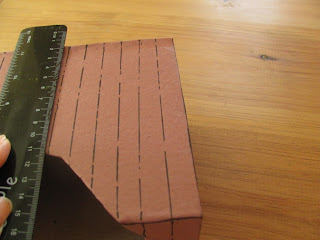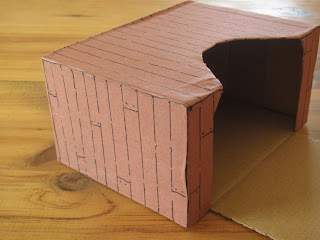13.11.15
Easy DIY Nativity - #christmascrafts
We made this Nativity scene a few years ago, and it worked really well (it's here if you'd like to have a look).
Thing is it's made out of paper, so, didn't really stand the test of time... though we do still have the three Wise Men.
They live on top of my spice jars in the kitchen.
It's been on my mind to make another nativity scene - a cardboard one this time, that should hopefully last a little longer, and I've been eyeing up the cat food box for a while, thinking it would make a pretty good stable? So, over the next few weeks I'll be sharing some ideas here.
If you don't have a cat, or a friend with a cat, then look out for any other packaging that's a similar sort of shape. This teabag box has a nice arched opening too, but your stable really doesn't have to have one - it could be the bottom end of a large cereal box or a dishwasher tablets box. As long as it's high enough for the figures (about 10cm).
I've kept the cardboard flap on our box, and might add something to it later, but it'll work just as well without.
Painting the stable is the easiest option.
Rub the shiny outside of the box with some sandpaper to remove the sheen and to give the paint something to grip to. To make a good 'stable' brown, mix a little red with a lot of yellow to make orange, and then keep adding small amounts of blue, until you're happy with the colour.
Probably need 2 coats.
I went for the slightly harder option and covered our box with brown paper. Does take a bit more time, but think it's worth it.
Start with the sides of the stable and cut out two identical bits of paper that are a bit bigger than the area you're covering.
To do this, place the box on one side on the paper, and line the bottom of the stable with the edge of the paper.
Mark a few dots about a cm out from the other 3 sides. This is so you have extra paper to fold over the edge of the box.
Use a ruler to join the dots. You need two pieces the same size (you could fold the whole sheet of paper in half and then cut them both out at the same time).
Brush craft glue evenly over one side, making sure you get into the corners, then line the piece of paper up with the bottom of the stable, making sure you have a similar size overlap on the edges. Press along the edges to crease the paper.
At each corner, snip a small triangle out of the brown paper to make it easier to fold - brush a line of glue along the edge of the box and stick the overlap down. Do the same on the other side. This will give you a much neater join when the rest of the stable is covered.
Cut a piece of paper that's the width of the stable - line the box up with the bottom corner of a sheet of brown paper, mark the width of the box, and use a ruler to draw a line along the whole length of the sheet. Cut out, following the inside of the line - you don't want this piece of paper to hang over the edges of your stable.
You might find, (as we did) that one piece of paper is not long enough to cover the front, top and back, so, cut another piece the same width as the stable, and make it a little bigger than the gap you need to cover, so there's an overlap.
Cover the front, top and back of the box with an even coat of glue, then, starting at the front, line up the paper with the bottom edge and carefully stick it down, a little at a time, pressing and smoothing as you go. If you're working with a box like mine you will be covering the arched opening too, like this.
If you're using the bottom end of a large cereal box, or something like a dish washer tablets box, then you'll only have to cover the top and back. To get a neat finish, leave a cm or so of paper hanging over the front edge, so you can fold and glue it underneath.
If you have an arched opening, cut the hole out, but don't go right up to the edge - leave a paper border of about 1cm around the arch.
Snip into this extra paper, up to the edge and crease it back, before gluing.
Once the glue's dried, (or paint if you've gone that route), then use a ruler and a black felt tip pen to add lines for a wooden tongue and groove effect. I found drawing a broken line like this worked well, giving it a more rustic look.
Don't worry if they're a little uneven - a bit of variety is good.
Randomly draw a few short lines going across some of the planks, to look like joins, and add two dots for nails.
For the straw, loosely fold a yellow and orange sheet of tissue paper together, and snip across to make really thin strips.
Unfurl your strands, then - the really fun bit - cut or tear and scrunch them up, until you're happy with your tissue paper straw. Place in the stable.
Figures next time!






















